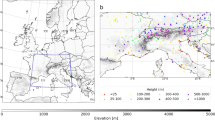Abstract
A moving-grid finite-element model has been developed to model numerically the vertically integrated properties of the atmospheric boundary layer (ABL) in one dimension. The model equations for mean wind velocity and potential temperature are combined with a surface energy budget and predictive equations for boundary-layer height to simulate both stable and unstable ABLs. The nodal position defining the top of the boundary layer is one of the model unknowns and is determined by boundary-layer dynamics. The finite-element method, being an integral method, has advantages of accurate representation of both bulk values and their vertical derivatives, the latter being essential properties of the nocturnal boundary layer. Compared with observations and results of other models, the present model predicts bulk properties very well while retaining a simple and economical form.
Similar content being viewed by others
References
Anthes, R. A., Kuo, Y.-H., and Gyakum, J. R.: 1983, ‘Numerical Simulations of a Case of Explosive Marine Cyclogenesis’, Mon. Wea. Rev. 111, 1174–1188.
Anthes, R. A. and Warner, T. T.: 1978, ‘Development of Hydrodynamic Models Suitable for Air Pollution and Other Mesometeorological Studies’, Mon. Wea. Rev. 106, 1045–1078.
Barker, E. H. and Baxter, T. L.: 1975, ‘A Note on the Computation of Atmospheric Surface Layer Fluxes for Use in Numerical Modeling’, J. Appl. Meteorol. 14, 620–622.
Boes, E. C.: 1981, ‘Fundamentals of Solar Radiation’, in Chapter 2 of J. F. Kreider and F. Kreith, (eds.), Solar Energy Handbook, McGraw-Hill, New York.
Brost, R. A. and Wyngaard, J. C.: 1978, ‘A Model Study of the Stably Stratified Planetary Boundary Layer’, J. Atmos. Sci. 35, 1427–1440.
Caughey, S. J., Wyngaard, J. C., and Kaimal, J. C.: 1979, ‘Turbulence in the Evolving Stable Boundary Layer’, J. Atmos. Sci. 36, 1041–1052.
Clarke, R. H., Dyer, A. J., Brook, R. R., Reid, D. G., and Troup, A. J.: 1971, ‘The Wangara Experiment: Boundary-Layer Data’, Tech. Pap. 19, CSIRO, Div. Meteor. Phys., Melbourne, Australia, 362 pp.
Davies, J. A., Schertzer, W., and Nunez, M.: 1975, ‘Estimating Global Solar Radiation’, Boundary-Layer Meteorol. 9, 33–52.
Deardorff, J. W.: 1972, ‘Parameterization of the Planetary Boundary Layer for Use in General Circulation Models’, Mon. Wea. Rev. 100, 93–106.
Deardorff, J. W.: 1974, ‘Three-Dimensional Numerical Study of the Height and Mean Structure of a Heated Planetary Boundary Layer’, Boundary-Layer Meteorol. 7, 81–106.
Deardorff, J. W.: 1978, ‘Efficient Prediction of Ground Surface Temperature and Moisture, with Inclusion of a Layer of Vegetation’, J. Geophys. Res. 83, 1889–1903.
Mahrt, L., Heald, R. C., Lenschow, D. H., Stankov, B. B., and Troen, I. B.: 1979, ‘An Observational Study of the Structure of the Nocturnal Boundary Layer’, Boundary-Layer Meteorol. 17, 247–264.
Malcher, J. and Kraus, H.: 1983, ‘Low-Level Jet Phenomena Described by an Integrated Dynamical PBL Model’, Boundary-Layer Meteorol. 27, 327–343.
McNider, R. T. and Pielke, R. A.: 1981, ‘Diurnal Boundary-Layer Development over Sloping Terrain’, J. Atmos. Sci. 38, 2198–2212.
Nieuwstadt, F. T. M. and Tennekes, H.: 1981, ‘A Rate Equation for the Nocturnal Boundary-Layer Height’, J. Atmos. Sci. 38, 1418–1428.
Smeda, M. S.: 1979, ‘Incorporation of Planetary Boundary Layer Processes into Numerical Forecast Models’, Boundary-Layer Meteorol. 16, 115–129.
Staley, D. O. and Jurica, G. M.: 1972, ‘Effective Atmospheric Emissivity Under Clear Skies’, J. Appl. Meteorol. 11, 349–356.
Stull, R. B.: 1973, ‘Inversion Rise Model Based on Penetrative Convection’, J. Atmos. Sci. 30, 1092–1099.
Thorpe, A. J. and Guymer, T. H.: 1977, ‘The Nocturnal Jet’, Quart. J. Roy. Meteorol. Soc. 103, 633–653.
Wyngaard, J. C., 1975, ‘Modeling the Planetary Boundary Layer-Extension to the Stable Case’, Boundary-Layer Meteorol. 9, 441–460.
Zeman, O.: 1979, ‘Parameterization of the Dynamics of Stable Boundary Layers and Nocturnal Jets’, J. Atmos. Sci. 36, 792–804.
Zeman, O. and Tennekes, H.: 1977, ‘Parameterization of the Turbulent Energy Budget at the Top of the Daytime Atmospheric Boundary Layer’, J. Atmos. Sci. 34, 111–123.
Zilitinkevich, S. S.: 1975, ‘Comments on the Paper of H. Tennekes’, J. Atmos. Sci. 32, 991–992.
Author information
Authors and Affiliations
Additional information
Journal Paper No. J-12996 of the Iowa Agriculture and Home Economics Experiment Station, Ames, Iowa, Project No. 2779.
Rights and permissions
About this article
Cite this article
Russell, R.D., Takle, E.S. A moving grid finite-element model of the bulk properties of the atmospheric boundary layer. Boundary-Layer Meteorol 46, 113–132 (1989). https://doi.org/10.1007/BF00118449
Accepted:
Issue Date:
DOI: https://doi.org/10.1007/BF00118449




